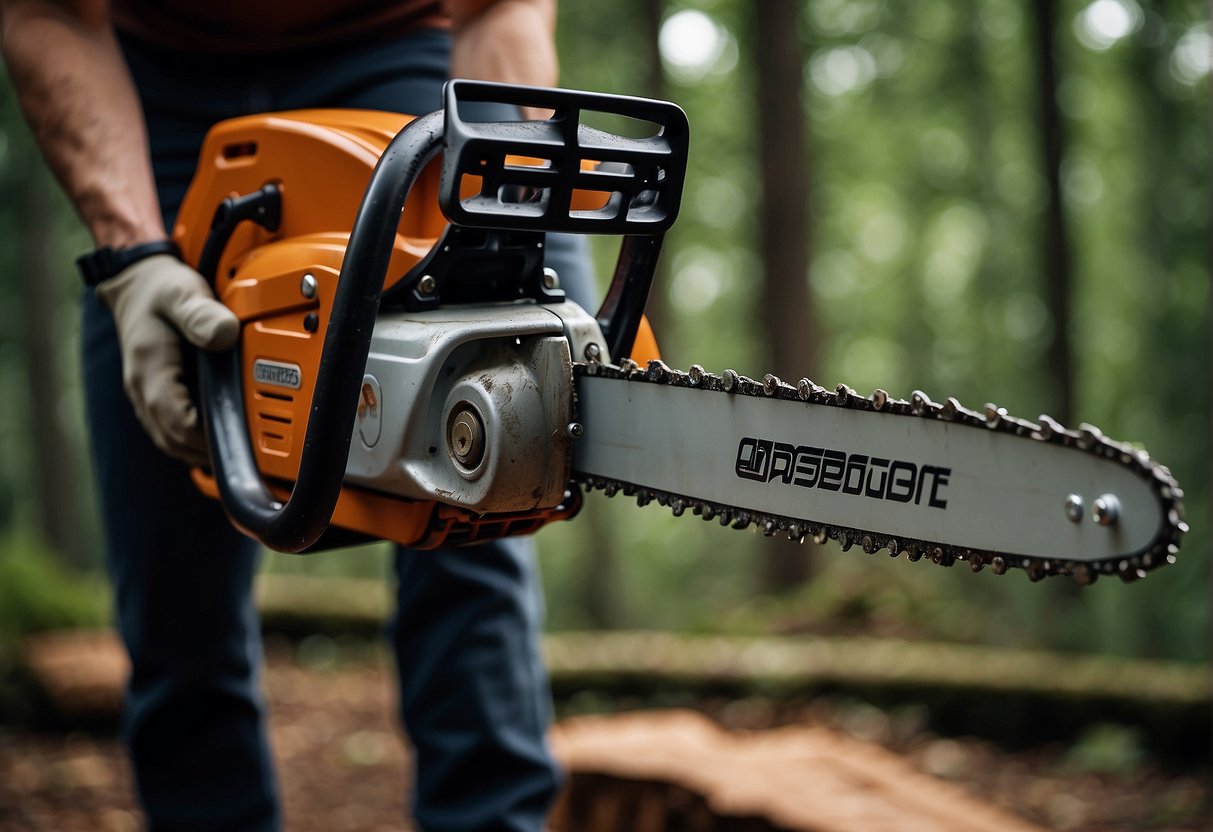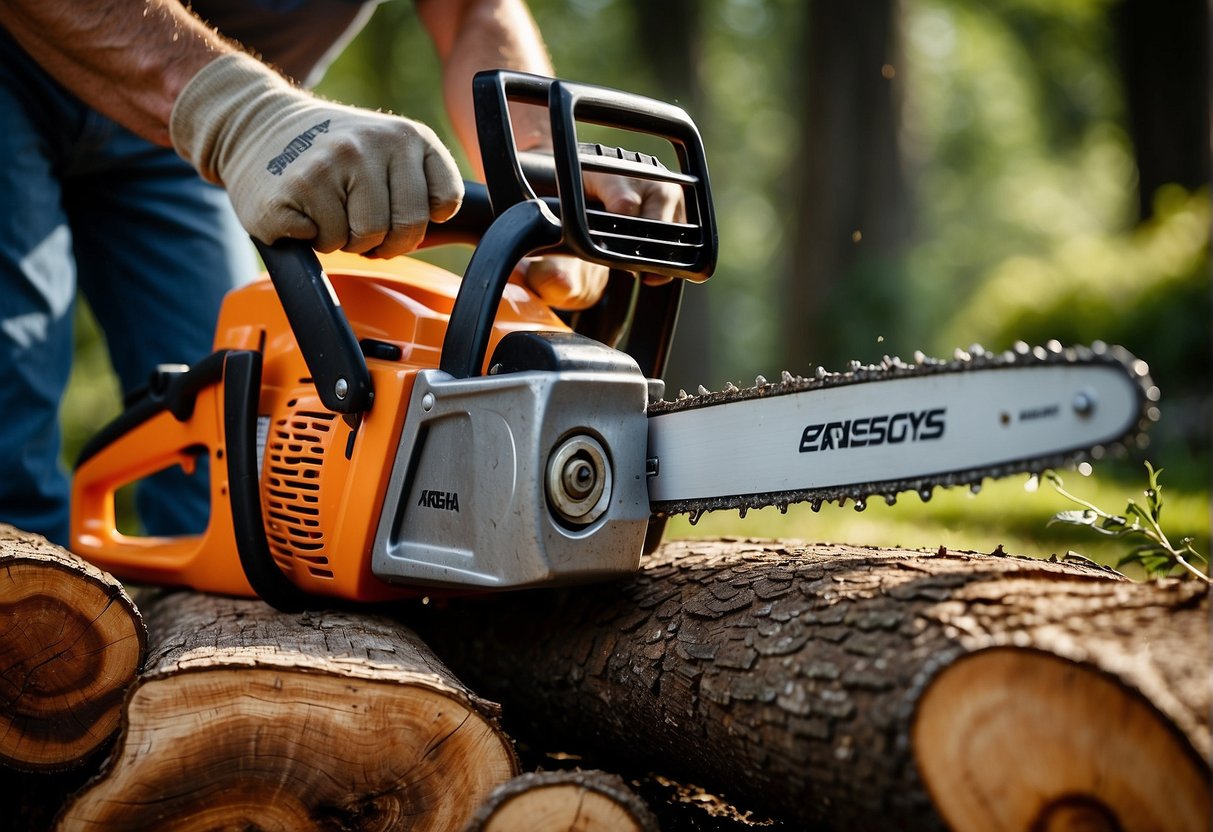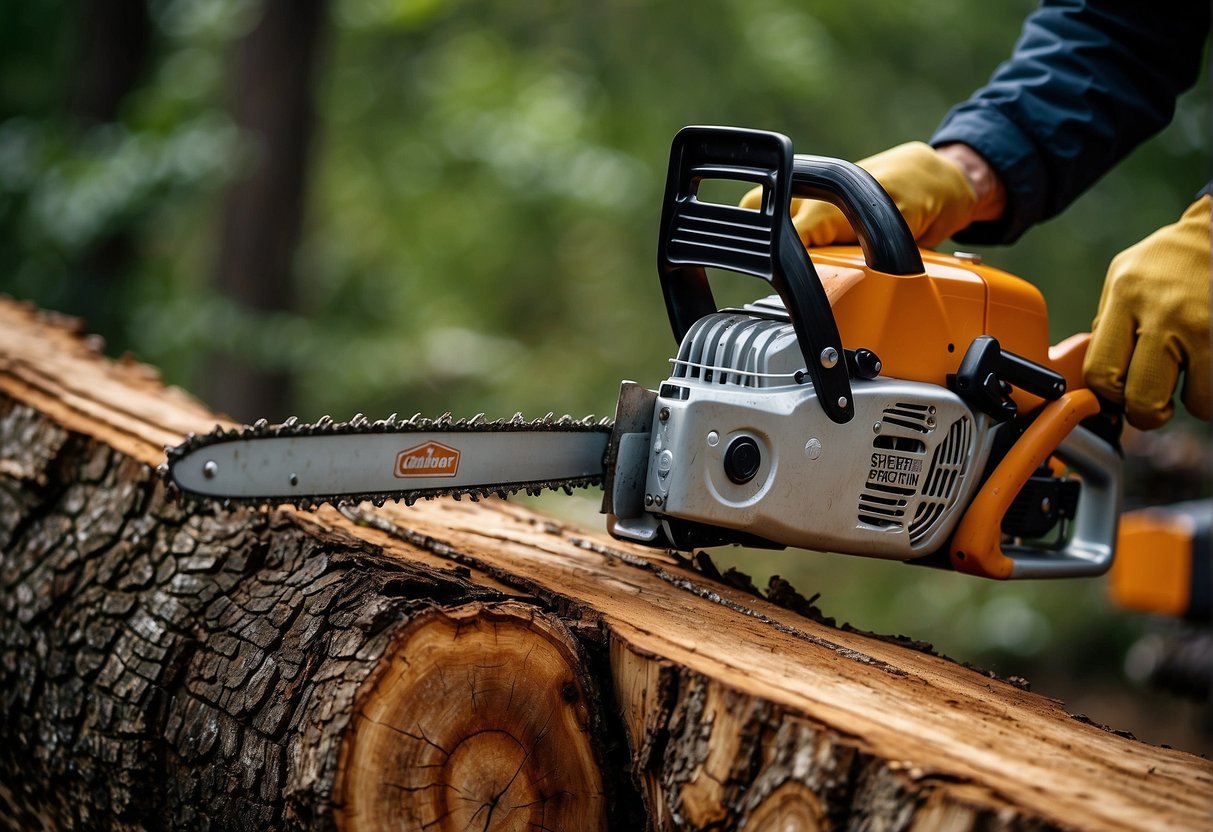When it comes to choosing a chainsaw, there are two primary types to consider: top handle and rear handle. Each type has its own unique features and benefits, and the right choice will depend on your specific needs and preferences. In this article, I will explore the differences between top handle chainsaws and rear handle chainsaws, and provide some insights to help you make an informed decision.

Understanding Chainsaws
Before we dive into the differences between top handle and rear handle chainsaws, it’s important to have a basic understanding of how chainsaws work. Chainsaws are essentially portable mechanical saws that are designed to cut through wood and other materials. They typically consist of a motor, a guide bar, and a chain with sharp teeth that rotate around the bar to cut through the material.
Design and Ergonomics
One of the biggest differences between top handle and rear handle chainsaws is their design and ergonomics. Top handle chainsaws have their handle placed on top of the machine, which makes them ideal for one-handed use and for working in tight spaces. Rear handle chainsaws, on the other hand, have their handle at the back of the machine, which provides more power and stability for larger cutting tasks.
Understanding Chainsaws
As a professional woodworker, I have a lot of experience working with chainsaws. Chainsaws come in different designs and sizes, but the two most common designs are top handle chainsaws and rear handle chainsaws. In this section, I will explain the features of each design and their benefits.
Top Handle Chainsaw Features
Top handle chainsaws are designed for one-handed use and are suitable for climbing or working in tight spaces. They are lightweight and easy to maneuver, making them ideal for pruning and trimming trees. The top handle of the chainsaw is located at the top of the saw, allowing for better control and balance. These chainsaws are typically smaller and less powerful than rear handle chainsaws.
Some of the key features of top handle chainsaws include:
- Lightweight and compact design
- One-handed operation
- Easy to maneuver in tight spaces
- Better control and balance
- Ideal for pruning and trimming trees
Rear Handle Chainsaw Features
Rear handle chainsaws are designed for heavy-duty cutting tasks and are more powerful than top handle chainsaws. They are larger and heavier than top handle chainsaws, but they offer more stability and power. The rear handle of the chainsaw is located at the back of the saw, providing better leverage and control while cutting.
Some of the key features of rear handle chainsaws include:
- More powerful than top handle chainsaws
- Better stability and control
- Ideal for heavy-duty cutting tasks
- Rear handle provides better leverage
- Suitable for felling trees and cutting large logs
Both top handle and rear handle chainsaws have their own unique features and benefits. When choosing between the two, consider the intended use and the user’s experience and comfort level. Top handle chainsaws are more flexible and easy to use, while rear handle chainsaws offer more power and stability.
Design and Ergonomics

When it comes to chainsaws, design and ergonomics play a crucial role in determining the ease of use and overall performance of the tool. In this section, I will discuss the design and ergonomics of top-handle and rear-handle chainsaws.
Handle Design and Placement
The handle design and placement are the most significant differences between top-handle and rear-handle chainsaws. As the name suggests, top-handle chainsaws have a handle located at the top of the saw, while rear-handle chainsaws have a handle located at the rear of the saw.
Top-handle chainsaws are designed for one-handed use and are ideal for climbing or working in tight spaces. The top handle allows for greater maneuverability and control in these situations. On the other hand, rear-handle chainsaws are designed for two-handed use and provide more power and stability for larger cutting tasks.
Weight Distribution and Balance
Another crucial aspect of chainsaw design is weight distribution and balance. Top-handle chainsaws are typically lighter and more compact than rear-handle chainsaws, making them easier to handle and maneuver. However, the weight distribution can be uneven, which can cause fatigue and discomfort during extended use.
Rear-handle chainsaws, on the other hand, have a more balanced weight distribution, which makes them more comfortable to use for extended periods. The weight is distributed evenly between the front and rear of the saw, which reduces the strain on the arms and shoulders.
Overall, the handle design, weight distribution, and balance are important factors to consider when choosing between top-handle and rear-handle chainsaws. The intended use, user experience, and comfort level should also be taken into account to ensure that you choose the right tool for the job.
Performance and Use Cases
When it comes to chainsaws, the top-handle and rear-handle models have different strengths and weaknesses. In this section, I will discuss the performance and use cases of each type of chainsaw.
Cutting Capacity and Power Output
One of the main differences between top-handle and rear-handle chainsaws is their cutting capacity and power output. Rear-handle chainsaws typically have larger engines and longer bars, making them more suitable for heavy-duty cutting tasks such as felling trees and cutting large logs. Meanwhile, top-handle chainsaws are designed for lighter tasks such as pruning and trimming. They have smaller engines and shorter bars, which makes them more maneuverable and easier to use in tight spaces.
Suitability for Tasks and User Experience
The suitability of each chainsaw type for different tasks largely depends on the user’s experience and comfort level. Top-handle chainsaws are generally easier to use for beginners and homeowners, as they are lighter and more compact. They are also ideal for tasks that require climbing or working in tight spaces, such as trimming tree branches. On the other hand, rear-handle chainsaws are better suited for professional use and heavy-duty cutting tasks. They are more stable and powerful, which makes them ideal for felling trees and cutting large logs.
In terms of user experience, top-handle chainsaws are generally more comfortable to use for extended periods of time due to their lighter weight and better balance. However, they require more skill and experience to use safely, especially when working at heights. Rear-handle chainsaws, on the other hand, are more stable and easier to control, which makes them more suitable for inexperienced users.
Overall, the choice between a top-handle and rear-handle chainsaw largely depends on the user’s experience, the type of cutting tasks they will be performing, and their personal preferences. While top-handle chainsaws are more suitable for light tasks and easier to use, rear-handle chainsaws are better suited for heavy-duty cutting tasks and professional use.
Safety and Handling

When it comes to chainsaws, safety should always be the top priority. In this section, I will discuss the safety features and handling of top handle chainsaws vs rear handle chainsaws.
Safety Features and Certification
Both top handle and rear handle chainsaws come with safety features such as chain brakes, throttle interlock, and anti-vibration systems. However, some models may have additional safety features such as automatic oiling systems, which reduce the risk of the chain overheating and breaking.
It’s important to note that chainsaws should meet certain safety standards and certifications. Look for chainsaws that are certified by organizations such as the Occupational Safety and Health Administration (OSHA) or the International Organization for Standardization (ISO).
Handling and Maneuverability
Top handle chainsaws are designed to be lightweight and compact, making them ideal for working in tight spaces or at heights. They are also easier to maneuver with one hand, which can be useful for pruning or trimming. However, they may not be as stable as rear handle chainsaws, especially when cutting larger trees.
Rear handle chainsaws are heavier and bulkier, but they offer better stability and control. They are ideal for cutting larger trees or for more demanding jobs. However, they may cause more fatigue and strain on the arms and shoulders.
In summary, both top handle and rear handle chainsaws have their advantages and disadvantages when it comes to safety and handling. It’s important to choose the right chainsaw for the job and to always follow safety guidelines and procedures.
Maintenance and Durability

Ease of Maintenance
When it comes to maintenance, both top handle and rear handle chainsaws require regular upkeep to ensure optimal performance and longevity. However, top handle chainsaws tend to be more complex and require more attention than rear handle chainsaws. This is because they have more moving parts and are designed for professional use. As such, it is important to have a basic understanding of the chainsaw’s components and how they work together.
To keep a top handle chainsaw in good condition, it is necessary to regularly check and replace the spark plug, air filter, and fuel filter. It is also important to keep the chain sharp and properly tensioned. In addition, it is recommended to inspect the chainsaw’s clutch, sprocket, and bar for signs of wear and tear.
On the other hand, rear handle chainsaws are generally easier to maintain and require less frequent attention. They have fewer moving parts and are designed for more casual use. However, it is still important to regularly check and replace the spark plug, air filter, and fuel filter. It is also recommended to inspect the chainsaw’s chain, bar, and sprocket for signs of wear and tear.
Durability and Longevity
Both top handle and rear handle chainsaws are designed to withstand heavy use and are built to last. However, their durability and longevity depend on several factors, including the quality of materials used, frequency of use, and level of maintenance.
Top handle chainsaws are generally made with high-quality materials and are designed for professional use. They are built to withstand heavy use and are designed to last for many years. However, they require more maintenance than rear handle chainsaws to ensure optimal performance and longevity.
Rear handle chainsaws are also built to last and are designed for more casual use. They are generally made with durable materials and can withstand frequent use. However, they may not be as durable as top handle chainsaws and may require more frequent replacement of parts due to wear and tear.
Overall, both top handle and rear handle chainsaws are durable and reliable tools for cutting wood. However, their durability and longevity depend on several factors, including the quality of materials used, frequency of use, and level of maintenance.
Frequently Asked Questions
What are the advantages and disadvantages of using a top handle chainsaw compared to a rear handle model?
Top handle chainsaws are ideal for arborist applications, as they are lightweight and easy to maneuver in tight spaces. They can be used with one hand, which makes them perfect for climbing trees. On the other hand, rear handle chainsaws are more powerful and provide better stability for larger cutting tasks. They are also easier to control when cutting horizontally. The choice between the two depends on the intended use and the user’s experience and comfort level.
Can top handle chainsaws be used for ground work, or are they exclusively for arborist applications?
Top handle chainsaws can be used for ground work as well, but they are primarily designed for arborist applications. They are lightweight and easy to maneuver, which makes them perfect for climbing trees. However, they can also be used for trimming and pruning on the ground. Rear handle chainsaws, on the other hand, are better suited for ground work as they provide better stability and control.
How does the weight of the lightest arborist chainsaw compare to standard rear handle chainsaws?
The lightest arborist chainsaws weigh around 6-7 pounds, while standard rear handle chainsaws can weigh up to 15 pounds or more. The weight of the chainsaw is an important consideration, as it affects the user’s comfort and control. Arborist chainsaws are designed to be lightweight and easy to maneuver, while rear handle chainsaws are designed for larger cutting tasks.
What are the safety considerations when operating a top handle chainsaw?
When operating a top handle chainsaw, it is important to wear protective gear, including a helmet, eye and ear protection, and gloves. It is also important to use the chainsaw properly and follow the manufacturer’s instructions. Top handle chainsaws can be dangerous if not handled properly, especially when used at heights. It is important to take safety precautions and use the chainsaw responsibly.
Are there electric top handle chainsaws that offer the same power as gas models?
Yes, there are electric top handle chainsaws that offer the same power as gas models. Electric chainsaws are becoming increasingly popular due to their low noise level, low emissions, and ease of use. They are also more environmentally friendly than gas models. However, gas models still offer more power and are better suited for larger cutting tasks.
What are the key differences between STIHL and Husqvarna’s top handle chainsaw offerings?
STIHL and Husqvarna are two of the most popular brands of chainsaws, and both offer top handle chainsaws. The key differences between the two brands are in their design, features, and performance. STIHL chainsaws are known for their reliability and ease of use, while Husqvarna chainsaws are known for their power and durability. The choice between the two depends on the user’s needs and preferences.

Hi, I’m Sal Muller of Tooltrip.com. My DIY experience led me to understand essential power tools for home projects. Tooltrip.com guides enthusiasts and professionals in choosing right tools for any job. I provide concise top tool reviews for easier, efficient DIY.

